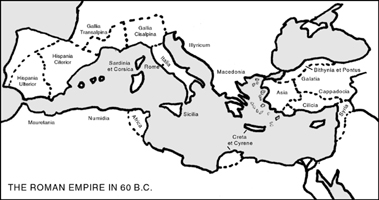 username@email.com
username@email.com
In the next section, we’ll review the fall of the Roman Empire and examine how (and where) Christianity rose to prominence in the medieval era.
In the preceding sections, we reviewed some early examples of written law and brushed up on some of the major figures of the Roman era, including Julius Caesar and Caesar Augustus.
The term medieval refers to the era of human history between the fall of the Roman Empire and the Renaissance. Founded around 645 BC, Rome grew under the Tarquin kings until they were overthrown by the Roman senate around 500 BC. The senate created stability, so much so that the city-state of Rome grew into one of the most famous and studied empires in history. In AD 324, the emperor Constantine built Constantinople (“new Rome”) on the site of ancient Byzantium on the Bosporus, a strait between the Black Sea and the Sea of Marmara. It connects Europe and Asia.

Roman Empire
This shift of power to the east sealed Rome’s fate, as the once glorious city was left vulnerable to attacks from the north by the barbarian tribes of Huns, Vandals, Ostrogoths, and others. Rome was sacked in AD 476, leaving Constantinople to eventually become the center of the Byzantine Empire, which would last until it was dismantled by Ottoman Turks in the fifteenth century.
As Christianity spread, it moved westward from Asia Minor into Europe. Monasteries began sprouting up in the heretofore Romanesque Frankish kingdoms. By the year 1000, the region now known as Germany served as the seat of an empire, with the church as its pivot point. It rivaled ancient Rome in authority and influence. The timeline below shows some of the events that marked Christianity’s rise in Europe.

Timeline of Christianity’s rise in Europe
While now out of favor with scholars, the phrase “the Dark Ages” was at one time used to describe what we’re labeling the “medieval era” in this course. Even calling this time frame “medieval” can be construed as pejorative, as the people living during that time certainly did not think of themselves as living in a time barren of artistic and intellectual quality.
It’s commonly agreed that Petrarch coined the phrase “dark ages.” Petrarch was a proponent of the artistic advancements of the Greeks and thought of their era as a halcyon time of enlightenment, contrasted with his lifetime, which he saw as degraded. In some senses, Petrarch was engaged in myth-making in hopes of spurring on a time where people valued the arts of antiquity.
We’ve already touched on the spread of Christianity, a medieval movement that would have dramatic consequences for centuries to come. Here are some other noteworthy events that prove there was certainly plenty of activity during the “Dark Ages.”
Beginning around the 3rd century, huge groups of Germanic and Slavic peoples moved about Europe. One of these groups, the Visigoths, was responsible for the coup de grace of the western Roman Empire (476). These peoples settled in what was once the western half of the Roman Empire. Another phase of the migration period brought more Slavic people into what is now eastern Europe.
In 1066, England was conquered by the Duke of Normandy, William the Conqueror at the Battle of Hastings. When Edward the Confessor died with no heir, the resulting power vacuum brought war to England. William used skillful recruiting to assemble a massive army and overwhelmed his rivals Harold Godwinson and Harald III of Norway.